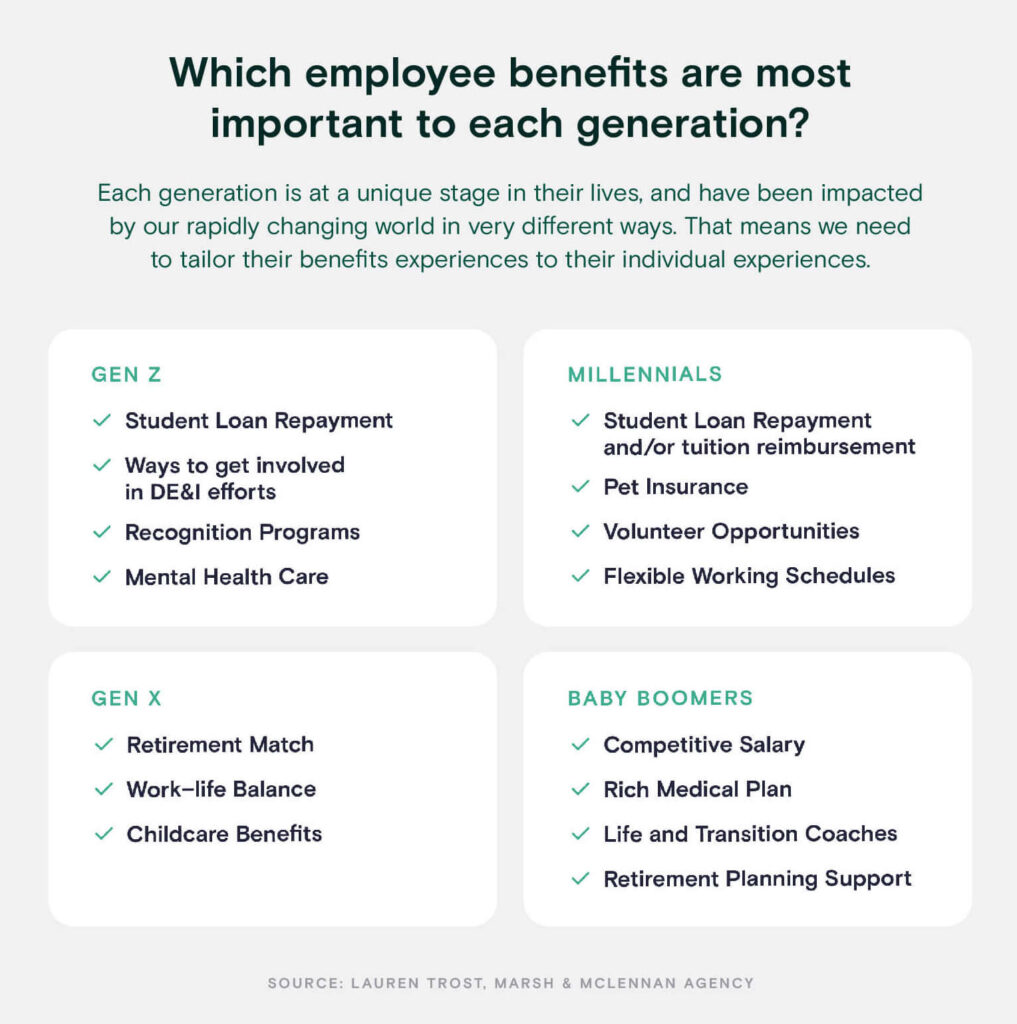Last year, we interviewed 200+ Jellyvision customers to learn about their 2022 priorities and how they’ve shifted their focus as terms like “Great Resignation” and “Quiet Quitting” took center stage.
This year, we’re bringing you a refreshed report with new insights, statistics, and recommendations. You might be wondering: what’s changed?
At first glance, it seems like the answer is “not much.” Urging employees to engage with their benefits year-round is still challenging. Employers are expanding their definition of “health” to include mental and financial needs. Employees are still in the dark about complicated, confusing benefits jargon (looking at you, HSAs).
However, taking a deeper look reveals that, actually, a lot has changed. Our workforces have expanded to include five different generations, which means HR teams are working harder to pair the right messages with the right people at the right time. The Great Resignation has dwindled, which means employers are now more focused on new hire education and retention than talent acquisition. And as a recession looms, organizations are focused on cost-saving initiatives for themselves and their employees.
Hold on. Does this mean you have even more things to worry about in 2023 than you did in 2022? Maybe. But here’s the thing: the world of work is constantly changing—especially in these last few years. And it’s impossible to keep up with every new trend, app, or workplace-related issue.
That’s why this report aims to cut through the fluff and only surface the most common, urgent trends we’re seeing—based on our in-depth conversations with other HR leaders. We hope that, through these insights, we can help you:
- Identify new priorities you might not have had the bandwidth to consider yet.
- Refine your existing strategies based on the latest information.
- Take action on whichever priorities you do choose to focus on in 2023.
TL;DR
Don’t have time to read the full report? No problem. We know you’re busy, so here’s the TL;DR version of the five HR priorities we uncovered for 2023:
- Year-round benefits engagement is still a challenge, and 64% of HR pros say it’s a priority. It’s not just about open enrollment—it’s about connecting employees with the right benefits, on the platforms where they’re already spending time, at the moment when they have a healthcare need.
- This year, retention beats acquisition. Employers aren’t hiring as aggressively as they were last year, but they’re focused on an important retention initiative: training and educating their new hires properly, so they’ll stay on board for years to come.
- “Well-being” means way more than just physical health. Like in years past, employers are expanding their definition of what “health” means, and they’re rolling out new resources and expanding existing ones to account for their employees’ entire well-being.
- What does HSA stand for, again? Employees are still in the dark about this important financial tool, and they’re missing out on the benefits. HR pros say they’re especially focused on health savings account education this year.
- Mental health is just as important as physical health. Employees say they’re still heavily impacted by stress and other mental health concerns, and they’re holding their employers responsible to support them.
2023 HR Priority 01
Promoting year-round benefits engagement
What’s at the tippity-top of HR pros’ lists this year? Helping employees take full advantage of their benefits offerings year round, not just at open enrollment.
This one’s been a big focus area for Jellyvision customers for years now, as organizations have expanded their benefits offerings to address recent health challenges and position themselves as a leading employer in a competitive job market.
With so many options to choose from, it’s harder than ever to ensure employees know about all of the resources available to them, and are using them effectively. But this is an especially relevant priority in 2023, as our workforces become more diverse than ever—especially when it comes to age. For the first time, there are five different generations in the workplace. As Gen Z enters the job market, Boomers are staying at work longer than ever before:
That means it’s never been harder to meet employees where they are, with the right benefits messages, at the right time. Each generation has its own unique needs when it comes to the resources they’re most likely to use, and no two employees are the same:

As our customers highlighted, benefits communication strategies are also more challenging with a multi-generational workforce. Younger employees prefer texting and social media, while older employees might prefer a phone call or a one-on-one conversation with an HR pro.
Here’s a step-by-step guide to building an effective year-round benefits communication strategy.
A shift to remote, dispersed workforces has also made it more difficult for HR teams to connect the right employees with the right benefits guidance year-round.
All hope is not lost, though. There are plenty of ways to make the benefits engagement process more manageable, as our customer, Niagara Bottling, proved:
Find out how Niagara Bottling uses ALEX to reach a dispersed workforce and improve employee engagement by 33%.
2023 HR Priority 02
New hire education and onboarding
After a rocky few years with lots of job market movement, things are settling down. Only 8% of Jellyvision customers told us they’re focused on talent acquisition in the year ahead as organizations recover from the Great Resignation and face budget cuts and layoffs.
Alternatively, HR pros told us this year is all about educating and retaining the new staff members they’ve already hired.
A spike in mergers and acquisitions is also affecting organizations of all industries, and HR pros tell us that’s adding pressure to their companies’ onboarding processes:
Our customers recognize that a strong benefits package is one of the strongest levers they can pull to avoid turnover and keep their staff happy, healthy, and engaged. And ongoing new hire education is crucial to building strong connections with employees, ensuring they understand and take full advantage of the resources available to them. Because unfortunately, we’re still missing the mark when it comes to giving employees the benefits information they need at onboarding:
The buck doesn’t stop on an employee’s first day. New hire education can take months (if not a full year), especially when it comes to benefits. Folks need time to interact with your healthcare plan options, learn the ins and outs, and understand which resources fit their personal needs the best.
So in the coming year, our customers are recommitting to a strong onboarding program—from day one to day 365. And we’re making it easy to join them!
Here’s a complete checklist to level up your 2023 new hire education experience.
2023 HR Priority 03
Holistic well-being initiatives
In 2022, HR pros told us that they were focused on creating more holistic health programs at their organizations, and this year was no different. 1 in 4 Jellyvision customers said employee well-being is a top priority.
Leading employers can no longer offer a great medical healthcare package and call it a day. HR pros recognize the importance of supporting every aspect of an employee’s health, from physical to mental to financial. Let’s look at how Jellyvision customers continue to roll out and expand their holistic wellness offerings.
Physical health
When it comes to physical health, leading organizations are all about taking a proactive approach. Preventative care and disease management were a major focus area with our customers, and employers are coming up with creative ways to incentivize employees to take action:
Other companies are pinpointing disease management as a solution to address high-cost claimants. HR pros told us they’re looking at their employee populations to determine which diseases cost the most money in healthcare and rolling out communications to drive prevention and early detection. For example, one company is increasing its focus on smoking cessation, while another is focused on virtual disease management programs for remote employees.
Financial wellness
The consequences of rising inflation are weighing on workers. According to PwC, only 42% of employees said their compensation was keeping up with the rising cost of living. In addition, one in four full-time employees is working more jobs than in previous years to make ends meet, and 56% are stressed about their finances.
Promoting retirement savings is also important to HR pros who are looking to address their aging workforces. Older generations are staying at work longer than ever, and it’s not just because life expectancy has risen. It’s also because they haven’t saved enough for retirement.
$35,345 (the median 401(k) balance) is not enough to live comfortably for years in retirement. So Jellyvision customers are especially focused on encouraging employees to save more, earlier.
Here’s how to break down 401(k)s, Roths, and other retirement concepts for your employees.
Family & childcare
Several HR pros mentioned that expanded family and childcare benefits were a priority for their organizations in 2023 as well. These programs are crucial for companies looking to make their benefits packages more inclusive, and we still have lots of work to do to make family leave and childcare more accessible to all.
Instead of using terms like “maternity leave” and “paternity leave,” turn to more gender-neutral, non-cis conforming language like “parental leave,” “family leave,” or “gestational leave.” Ask yourself these questions as well:
- Does your organization have benefits that are inclusive of same-sex and non-biological parents (e.g., adoption benefits)?
- Does your organization have benefits that support current and future caregivers beyond what is legally required (e.g., childcare or childcare subsidies, expanded parental leave, eldercare leave, fertility support)?
- Does your organization provide managers with guidelines on how to provide access to flexible work arrangements for all employees who need them?
2023 HR Priority 04
HSA education
It’s one of a bazillion healthcare acronyms that often gets lost in translation and, thus, largely ignored by those who need it most. We’re talking about the HSA, otherwise known as the health savings account.
HSAs offer tax advantages for both employees and employers, and they’re one of the most important financial tools in the benefits toolbox. But they’re also underfunded and underutilized, which is why employers are making them a top priority in 2023:
And that’s a good thing because we still have a lot of work to do when it comes to helping employees take full advantage of their medical savings accounts.
Learn more about why HSAs should be a top priority for employers this year and how ALEX can help.
2023 HR Priority 05
Mental health initiatives
Keeping with the holistic wellness approach that’s become increasingly popular in the last few years, mental health remains a top priority for many employers.
Last year, Jellyvision customers told us they were introducing new mental health benefits and increasing their communications to ensure employees felt supported and aware of what’s available. In 2023, that trend isn’t slowing down.
While a focus on mental health isn’t necessarily revolutionary this year, it’s still just as important as it has been in the past. Employees are still reporting high levels of stress, and they’re looking to their employers for more support:
Here’s how Jellyvision customers are stepping up to the plate in 2023, rolling out new mental health resources or expanding the programs they already have:
- Expanding and revamping EAPs
- Focusing on strategic communications of available offerings
- Introducing new vendors and programs
- Increasing utilization and expanding benefits communications
Here’s how to responsibly help your employees take a mental health leave of absence.
Key Takeaways for 2023
Our conversations with HR leaders reveal that many of the priorities from 2022 are carrying over into 2023.
What’s changed is that, as organizations start to take action on these issues, they’re discovering challenges and thinking of new ways to approach these problems—whether that’s with regard to communication, engagement, or awareness.
And that’s a great thing! It’s natural to run into obstacles while testing out new strategies. And as just about everything has changed in the past three years, it’s expected that we’d have to learn as we go and evolve our approach to HR and benefits, too.
This year has also introduced new priorities for employers to think about, such as retaining the talent you’ve hired recently and addressing the multi-generational workforce. We’re excited to see how companies tackle these challenges over the next few months and report back on their results in 2024.
We know this was a lot of information. So if there’s anything you take away from this report, it’s this:
- When it comes to employee well-being, the goal isn’t perfection—just get the ball rolling and find ways to improve on your strategy as you go.
- Communication is key for all benefits, but especially for undervalued programs like mental health and financial wellness resources.
- Year-round benefits engagement is hard. Keep experimenting, iterating, and learning.
- Your benefits package can be a true differentiator when it comes to your employer brand.
Before we close out this report, we just want to say you’re doing an awesome job. We know these past few years have been challenging, stressful, and, frankly, exhausting. But all the hard work you’re putting into these priorities? It matters. And we—along with your employees—appreciate everything you do.
Methodology
Jellyvision performed a qualitative survey of 200+ companies from December 2022–February 2023 via phone interviews. Job titles of individuals surveyed include VP of human resources, global director of benefits and compensation, HR specialist, benefits strategy manager, total rewards consultant, and others. Company size ranged from small- and medium-sized businesses to large enterprises. All interview participants are based in the U.S.


